I used to work as an English – German freelance translator next to studying and still accept translation jobs from time to time. I will share all my knowledge, including mistakes I did in the beginning, with you. I love translating and want to show you how to become a freelance translator, too.
| Investment needed: | None! |
| Working hours: | You choose how much you work |
| Earning possibilities: | $8 - $100 per hour |
| Skills needed: | Speaking two or more languages |
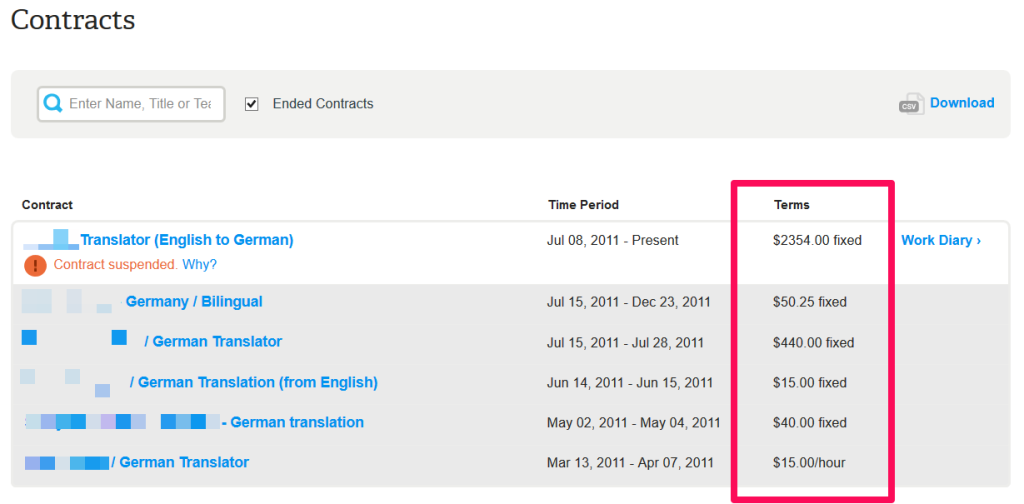
Last year, I hired translators from freelancing websites myself. This means that I know both viewpoints, the point of view of a client and freelance translator!
Requirements to become a freelance translator
Many people think that a freelance translator has to be perfect in both languages he/she wants to translate between. This is wrong. Many translators grew up bilingual or lived in a foreign country, but this is not a requirement. You can also translate FROM language one TO language two and not the other way around. I only translate from English to German. The reason is that my English skills are not good enough to write a professional sounding text without errors.
I hope you like my blog anyway 😀
However, I can read and understand even complex academic texts in English and my German skills are nearly perfect. There is nothing that hinders me from translating just one way.
Excellent language skills
You need to have excellent language skills in at least one of the languages you translate to. This usually means that freelance translators are native in the language and had some sort of education. You need to know spelling and grammar rules, exceptions from the rules and a lot vocabulary.
Time management
You need to have enough time for the job as a freelance translator. If you are short on time, you have to manage your available time more efficiently.
It is an advantage if you are very flexible in terms of your time schedule, like it was the case with me being a student. This enables you to choose jobs that have a short deadline. A job labelled as urgent will usually have a higher payout and at the same time a lower number of applicants. Not every freelance translator has the time to work many hours in a row. This often gave me an advantage and left a happy client when he could get the project finished in such a short time.
Patience
Especially in the beginning you need to have a lot of patience. It might be the case that you apply to dozens of jobs without getting a chance to show your skills. Without feedback you won’t get any jobs and without jobs you won’t get any feedback. It takes time to break through this cycle. The first three jobs are usually the hardest to get. It gets only easier after that!
Optional: Specialization
It’s not a requirement, but a very big advantage if you have some kind of special knowledge. You can earn a lot more than a regular freelance translator if you have legal or medical knowledge. These niches are highly paying and have a shortage of translators. Other sorts of specialized knowledge bring also advantages with them.
As I studied computer science, I know all technical terms in English and German. This gave me an advantage over other applicants when applying to translate texts about a technical subject. The clients knew that I wouldn’t choose a wrong term by accident and make their texts appear stupid.
I often translated Android apps to German and due to my programming skills I was able to translate within the developer’s source code. This meant big time savings for them. There was no need for them to look for every piece of text, put it in a document, wait for my translation and then put it back in the code.
Finding translation work
Every freelance translator should register at freelancing websites! It’s the easiest and quickest way to get translation jobs.
Find freelance translation work on oDesk
You should fill out your profile and upload a profile picture. I also recommend to take the oDesk tests for the languages you want to translate between. This will help to find clients in the beginning when you don’t have any feedback. You can decide to display the test result and you should only do that if you have a good result above average.
You can find translation jobs on oDesk here:
Find Work > Find Jobs > Edit Categories > Tick “Translation” and “Other – Writing and Translation”
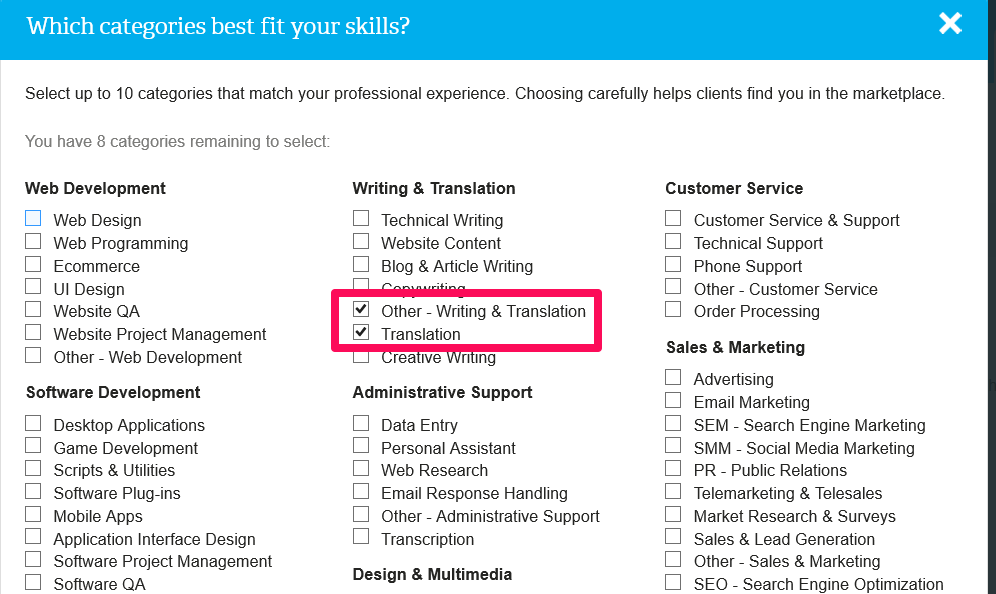
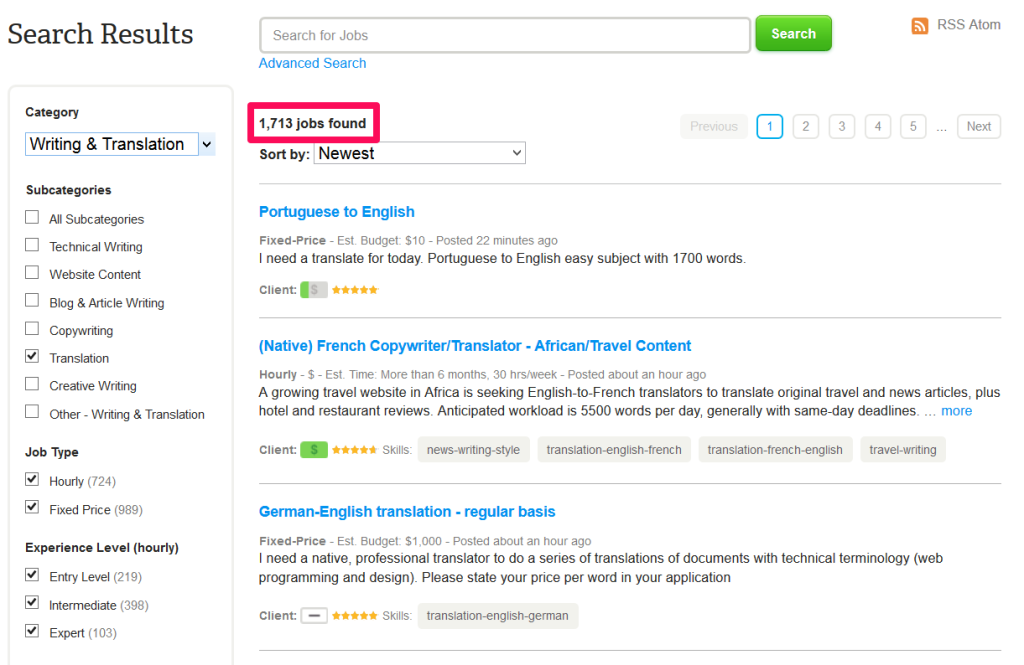
Find freelance translation work on Elance
Fill out your Elance profile with all relevant skills and experiences. Similar to oDesk, you can also do tests to proof your skills. You should do some translation related tests. If you have some money to spend, you should consider buying a higher membership status. This is not compulsory but will make things easier as you can apply to more jobs and appear higher in the searches.
Elance translation jobs can be found here:
Find Work > Search Jobs > Writing & Translation > Tick “Translation” and “Other – Translation”
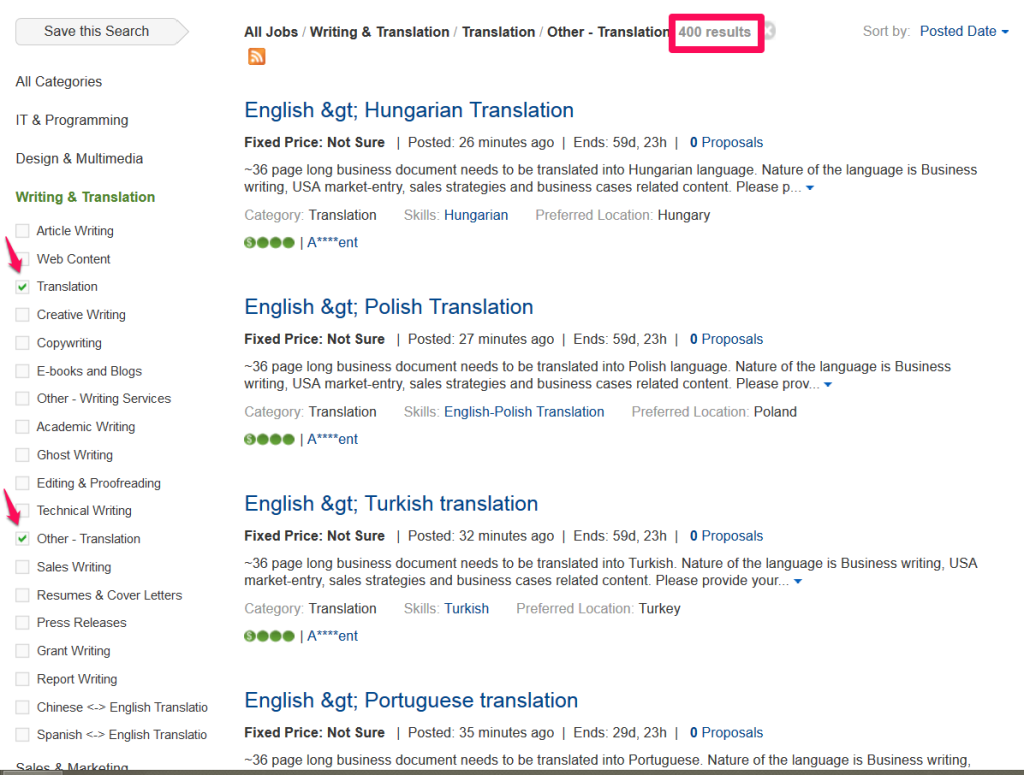
Find freelance translation work on Freelancer
There aren’t so many translation jobs available here compared to the other two freelancing sites. However, it’s definitely worth a try. Make your profile looks professional and you are ready to apply!
Translation jobs on Freelancer are shown here:
Browse Projects > Browse Categories > Writing & Content > Translation

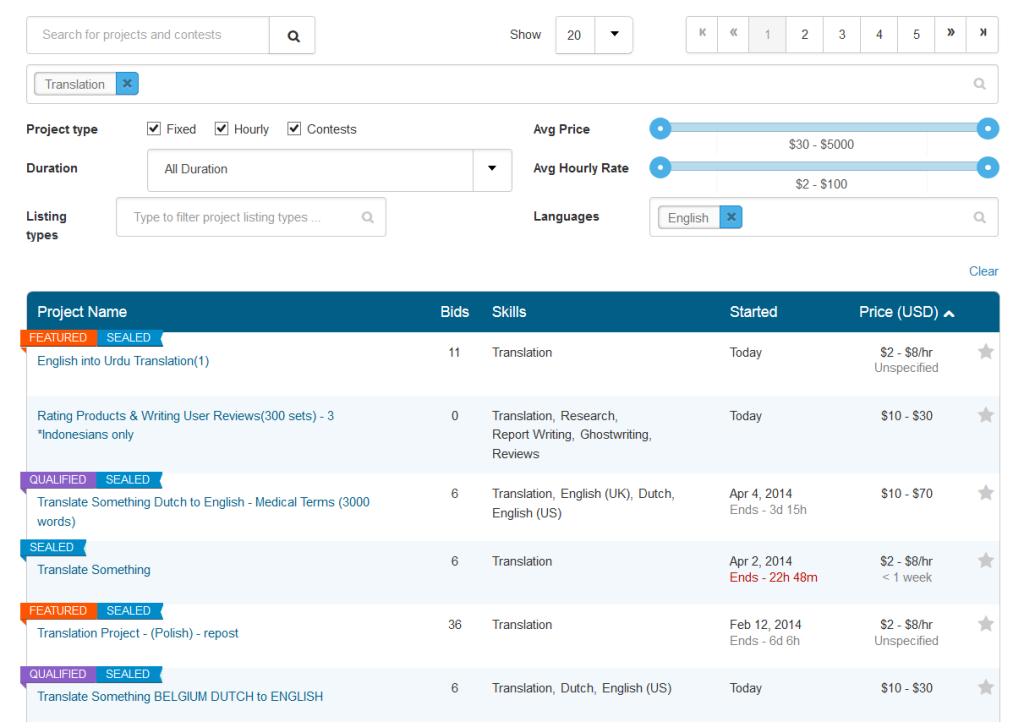
Apply for translation jobs
Now that you know where you can find translation jobs, I shall give some advice on applying for them.
Read the job description carefully
The job descriptions sometimes contain information that is not obvious, e.g. the client might has a special requirement. Some clients will require an application in a language other than English! You have to read the description carefully and only then decide if you want to apply for the job.
Repeat information from the job description
Most freelancer translators create a template that they use for every application. They write about their experience, skills, hourly rate etc. and copy & paste this to every job offer. It is not a bad idea to create such a template, but to copy and paste it to every job offer is very unprofessional. I have hired from freelancing sites myself and it is a big advantage if you know the applicant has actually read and understood your job description. Therefore, you should repeat some information that is written in the job description. For example:
Bad
“[…] I did translations for many clients here on oDesk and I would like to translate your text to German language, too. I always deliver the translated documents back fast. […]”
Good
“[…] I am available to do the German translation of your online book shop “MegaBookStore”. I can deliver the translated document within in your deadline of 10 days. […]”
Make sure you can meet the deadline
You have to check the deadline and make sure you are available. Don’t plan your time too short. The client will most likely give you a negative feedback if you fail to deliver on time. It’s better to have some buffer time to be able to proofread what you wrote.
Keep your tone professional
You might be thinking that this is obvious. It is not. Trying to find freelancers on freelancing sites can be quite shocking as a client.
Most freelancers know how to write a decent application but there are also some really crazy people. For example, I had people calling me “Mr. Germany Harmony”, “Master Sir” and other weird stuff. There were people that reacted very aggressively when I asked them for further details about what they are planning to do.
The tone of your application should be friendly, calm and respectful. This will make you appear as a professional person one can trust and send large sums of money to.
Example of a freelance translation job application
I want to show you an example of an application that I received and really liked. It was for the translation of a company website and corporate materials (flyers etc.). I’m not saying that this application is perfect but it has everything I’m looking for as a client.
The applicant writes clear and concise, understood the job description, fulfills the requirements, provides relevant examples of work, can meet the deadline and is open to further questions.
Dear Sgt Kraut,
herewith I offer your company my experience and skills for this project (high quality English to German translation of corporate materials and a company website).
As a professional translator with 6 years of experience and an appropriate educational background (studies of German Linguistics as well as Journalism at Freie Universität Berlin), I can offer you the quality that is required for the project.
Translation of various corporate materials is part of my daily work experience. I’m specialized in translating documents related to PR/Media, Marketing (core specialization), with intense experience in the fields Law General/Legal Basic (Contracts, T&C), Patents and Financial documents. I also bring extensive experience with localization of company websites and software.
You can see company websites I translated previously here:
Website1
Website2
Website3More translation samples are in my profile.
I can meet the deadline which you have set at 12.12.2012.
Please kindly refer to my profile page for further information and feel free to get in contact in case there are any questions.
Best Regards,
Translator
Start working as a freelance translator
Once your application got accepted, you should open all bottles of wine in the house! Or better concentrate and start working (and after that drinking).
Word processing software
There are many tools that can help professional translators. However, most of them are expensive and require time to get used to them. I never used one of those. What you definitely need is a word processing software with spell checking. If you are on low budget, you can download the free OpenOffice. I’m using the famous Microsoft Office, but I also have OpenOffice installed to open od* file extensions.
It would be quite embarrassing if the translation would have perfect grammar but typos in it. Therefore, you shouldn’t translate a text without spell checking.

As helpful as spell checking is, you can’t solely rely on it! All spell checkers have trouble finding out the context and meaning of a sentence. The spelling might be correct, but the wrong word could be used for the context. For example, let’s say you are translating to English language. You could confuse words such as “bare/bear, born/borne, brake/break, loose/lose” and it won’t be marked as wrong.
The translation process
Actually, there is not the one and only translation process. Every freelance translator will have different preferences and working styles. I wrote below how the translation process works for me and maybe you’ll find some points useful for yourself.
1. Reread the instructions
I want to make sure that I know what is expected from me. Therefore, I read the client’s instructions again.
2. Make myself familiar with the document
Sometimes I had the chance to read the document before accepting the job. If this not the case, I make myself familiar with the document by first quickly scanning through it and then reading it slowly.
3. Create a new document
I create a new document in the file format the client wants. I put the original document in a window next to the new document.
4. Translate paragraph after paragraph
Most of the time, I translate paragraph after paragraph (not sentence after sentence). This usually delivers better results as the meaning and what the text has to say is translated rather than single sentences. Sentence after sentence translations make the text sound like a translation. Most clients prefer when it sounds like an original text. However, some texts need to be translated sentence after sentence as they require absolute precision, for example the text within a contract.
5. Check for errors
Use the spell check but also read through the text and give attention to grammar, spelling errors and style. Maybe the main point could be expressed in a better way.
6. Recheck the next day
If enough time is left, I recheck the translated document the next day. Sometimes I notice errors that I overlooked the last day. A good trick is to read the text backwards; from end to beginning. Your brain won’t be so busy with processing the meaning and you can concentrate better on finding spelling mistakes.
7. Send the translated document back
If I am happy with the translation, I send it back to the client on time. I always make sure to send the translated file back with the same file extension I received it. Don’t change .docx to .odt if you are not instructed to do so. Maybe the client can’t open another file extension.
Learn from my mistakes
I want to share some mistakes I did in the beginning with you. Hopefully this the keeps you off from doing the same!
Too proud to work for low prices
When I first started with freelance translating I didn’t want to work for anything under $11/hour. Quite reasonable when living in a country with $11 minimum wage I guess. However, this slowed down the process of being able to raise my hourly rate a lot.
In the beginning, you need a lot of good feedback to attract other clients. Therefore, I recommend to be ready to work for lower wages than you would do normally. Don’t sell yourself short and work for $3 or something, but lower your earning expectations. You will be able to charge your desired rate only if your feedback shows you are worth it.
Make a lot of clients happy and they will give you an appropriate feedback. More Feedback > More Clients > More Money.
Not asking for feedback
On most of the freelancing websites giving feedback is optional. As a freelance translator you need good feedback to attract more clients and be able to raise you rate.
I did this mistake in my first translation task. I delivered a perfect translation, the client was satisfied, thanked me in a personal message but never submitted a feedback in the oDesk rating system. I should have actively asked for feedback!
This mistake never happened to me again as I told all clients who didn’t submit feedback that it would really help me to enhance my career. Every client then understood why this is important! I think the problem is that most people underestimate the power of feedback. However, I don’t recommend to be begging for feedback several times. One time is enough and if the client doesn’t want, so be it.
Good Luck!
I wish you all the best for your translation career! This is obviously only if you don’t translate from English to German and become my competitor 😀
Please don’t refrain from asking questions. I shall answer them by adding the answer to the article or the comments below.



